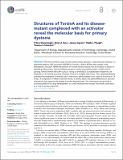| dc.contributor.author | Demircioglu, Fatma Esra | |
| dc.contributor.author | Ingram, Jessica | |
| dc.contributor.author | Ploegh, Hidde | |
| dc.contributor.author | Schwartz, Thomas | |
| dc.contributor.author | Sosa, Brian A. | |
| dc.date.accessioned | 2016-11-04T20:54:13Z | |
| dc.date.available | 2016-11-04T20:54:13Z | |
| dc.date.issued | 2016-08 | |
| dc.date.submitted | 2016-05 | |
| dc.identifier.issn | 2050-084X | |
| dc.identifier.uri | http://hdl.handle.net/1721.1/105219 | |
| dc.description.abstract | The most common cause of early onset primary dystonia, a neuromuscular disease, is a glutamate deletion (DE) at position 302/303 of TorsinA, a AAA+ ATPase that resides in the endoplasmic reticulum. While the function of TorsinA remains elusive, the DE mutation is known to diminish binding of two TorsinA ATPase activators: lamina-associated protein 1 (LAP1) and its paralog, luminal domain like LAP1 (LULL1). Using a nanobody as a crystallization chaperone, we obtained a 1.4 A˚ crystal structure of human TorsinA in complex with LULL1. This nanobody likewise stabilized the weakened TorsinADE-LULL1 interaction, which enabled us to solve its structure at 1.4 A˚ also. A comparison of these structures shows, in atomic detail, the subtle differences in activator
interactions that separate the healthy from the diseased state. This information may provide a structural platform for drug development, as a small molecule that rescues TorsinADE could serve as a cure for primary dystonia. | en_US |
| dc.description.sponsorship | National Institutes of Health (U.S.) (Grant AR065484) | en_US |
| dc.description.sponsorship | National Institutes of Health (U.S.) (Director’s Pioneer Award) | en_US |
| dc.description.sponsorship | Foundation for Dystonia Research | en_US |
| dc.description.sponsorship | National Institute of General Medical Sciences (U.S.) (Grant P41 GM103403) | en_US |
| dc.language.iso | en_US | |
| dc.publisher | eLife Sciences Publications, Ltd. | en_US |
| dc.relation.isversionof | http://dx.doi.org/10.7554/eLife.17983 | en_US |
| dc.rights | Creative Commons Attribution 4.0 International License | en_US |
| dc.rights.uri | http://creativecommons.org/licenses/by/4.0/ | en_US |
| dc.source | eLife | en_US |
| dc.title | Structures of TorsinA and its disease-mutant complexed with an activator reveal the molecular basis for primary dystonia | en_US |
| dc.type | Article | en_US |
| dc.identifier.citation | Demircioglu, F Esra et al. “Structures of TorsinA and Its Disease-Mutant Complexed with an Activator Reveal the Molecular Basis for Primary Dystonia.” eLife 5 (2016): n. pag. | en_US |
| dc.contributor.department | Massachusetts Institute of Technology. Department of Biology | en_US |
| dc.contributor.department | Whitehead Institute for Biomedical Research | en_US |
| dc.contributor.mitauthor | Demircioglu, Fatma Esra | |
| dc.contributor.mitauthor | Sosa-Alvarado, Brian Alexander | |
| dc.contributor.mitauthor | Ingram, Jessica | |
| dc.contributor.mitauthor | Ploegh, Hidde | |
| dc.contributor.mitauthor | Schwartz, Thomas | |
| dc.relation.journal | eLife | en_US |
| dc.eprint.version | Final published version | en_US |
| dc.type.uri | http://purl.org/eprint/type/JournalArticle | en_US |
| eprint.status | http://purl.org/eprint/status/PeerReviewed | en_US |
| dspace.orderedauthors | Demircioglu, F Esra; Sosa, Brian A; Ingram, Jessica; Ploegh, Hidde L; Schwartz, Thomas U | en_US |
| dspace.embargo.terms | N | en_US |
| dc.identifier.orcid | https://orcid.org/0000-0002-3866-2742 | |
| dc.identifier.orcid | https://orcid.org/0000-0002-1090-6071 | |
| dc.identifier.orcid | https://orcid.org/0000-0001-8012-1512 | |
| mit.license | PUBLISHER_CC | en_US |
| mit.metadata.status | Complete | |
